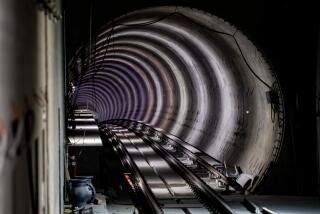High above the freeway, a slow road ahead
- Share via
Los Angeles escaped the dreaded “Carmageddon” gridlock that was expected to accompany the closure of the 405 Freeway last month, but residents and commuters high above the freeway on Mulholland Drive fear they are in for two years of motoring mayhem.
With a handful of high-toned private schools preparing to resume classes this week, and the Mulholland Drive bridge half-demolished, traffic along the leafy hilltop will slow to a crawl, residents say.
“You’re putting thousands of students and cars onto one single road that’s already overextended,” said Nayssan Finer, president of the Bel-Air Knolls Property Owners Assn. “It doesn’t take a brain surgeon to realize this will be a disaster.”
Transportation officials acknowledge that the widening of the 405 Freeway between the Westside and the San Fernando Valley and the accompanying reconstruction of the Mulholland Drive bridge will result in congestion for hilltop residents and commuters.
The intersection of Skirball Center Drive and Mulholland in particular is bound to be a “major problem,” said Ron Macias, a community relations officer for the Los Angeles County Metropolitan Transportation Authority, which is partnering with the California Department of Transportation on the $1-billion freeway-widening project through the Sepulveda Pass.
But Macias said the situation could have been avoided had neighborhood groups not vetoed an alternative during the run-up to construction. The two agencies in February proposed to reduce congestion by building a new, realigned bridge before tearing down the old one. That would have kept the Mulholland bridge at four lanes rather than two.
Although city and county leaders supported the plan as more efficient and less costly, some property owners opposed it, arguing that the design was not in keeping with Mulholland’s unique rustic character. They also complained that officials had not presented enough environmental data.
Under pressure to complete the project by 2013, transportation officials reverted to the idea of demolishing and rebuilding half of the bridge at a time over the next two years.
Mulholland Drive has long been a shortcut for Valley commuters. Since the southern half of the Mulholland overpass was demolished in July, vehicles have sometimes backed up for more than a mile, Finer said.
David Massoudi, a resident of Bel-Air Knolls, said his wife had no problem getting their youngster to preschool at Stephen S. Wise Temple and Schools before the bridge work began. Now, he said, it can take as long as 50 minutes to travel a mile from their residence to the freeway.
“You’re afraid to leave the house,” Massoudi said.
Things will probably get worse this week as classes resume Monday at the Berkeley Hall and Mirman schools, as well as the Wise elementary and middle schools.
The nine preschools and elementary, middle and high schools that stretch for a mile and a half along Mulholland serve about 2,700 students, said Robert Woolley, marketing director at the Mirman School and institutional coordinator for the Mulholland Educational Corridor Assn., a coalition that also includes American Jewish University and Skirball Cultural Center. Forty percent of the students come from the Valley; 60% commute from the Westside. The schools for years have staggered their start times from 7:30 to 9 a.m. More recently, they have also encouraged parents to carpool and sign up for bus routes.
Jaynee Beckman, who lives near UCLA, was all set to drive her two children each day to Mirman, a school geared to high-IQ children, until she saw the current state of the Mulholland bridge.
“When I saw it was down to two teeny little lanes,” she said, “I couldn’t believe it.”
She put their names on the waiting list for bus service. She figures the savings in time and frustration will be worth the $2,400-per-child transportation fee, on top of $23,000 in tuition.
Some residents and parents have faulted the MTA for failing to devise adequate alternatives for commuters and residents. Transportation officials say they simply don’t have many options for absorbing the 20,000 or so motorists who use Mulholland Drive each weekday.
“It’s a geographically constrained corridor with not very many good alternatives,” said Dave Sotero, an MTA spokesman.
The MTA’s best hope is “to deter morning commute traffic from the Valley,” Macias said. The agency has begun posting digital alerts along Hayvenhurst Avenue, Beverly Glen Boulevard and other popular routes. As school classes resume, it will also position a traffic officer at Mulholland and Skirball temporarily “to allow motorists to get acclimated,” Macias said.
Rebuilding the Sunset Boulevard, Skirball Center and Mulholland bridges is part of the effort to create a 10-mile carpool lane on the northbound 405 between Interstate 10 and U.S. 101. Work is scheduled to begin in November on Wilshire Boulevard freeway on- and off-ramps. There are eight ramps; over the next two years, two will close at a time for two weeks to three months.
The massive project has already brought drivers plenty of closure-related misery. Major construction began with demolition of half of the Sunset bridge in July 2010. Demolition started on the Skirball overpass last October.
In mid-July, half of the Mulholland bridge came down during Carmageddon weekend, when the 405 was closed for several miles in each direction. After weeks of warnings that the work would create massive jams, most motorists heeded the advice of politicians and transportation officials to steer clear of the project.
More to Read
Sign up for Essential California
The most important California stories and recommendations in your inbox every morning.
You may occasionally receive promotional content from the Los Angeles Times.














